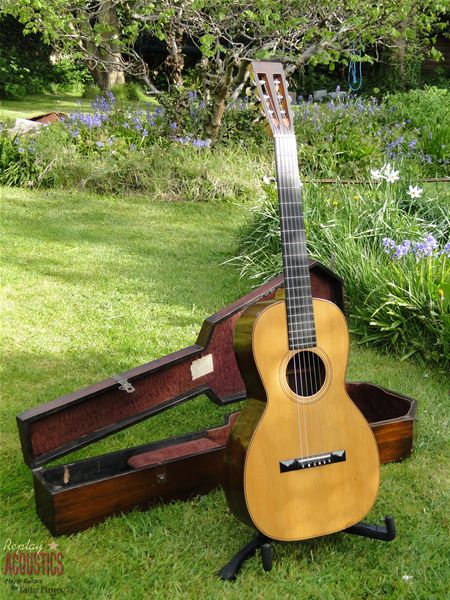Posted on Wednesday 20th January 2016
 Little comes to press about the pre- 1900 martin parlour guitar, and for fairly good reason: you never see them and you never get to play them. they are often mistakenly dismissed as inconsequential guitars with little musical value, but they are sophisticated instruments with much to offer if you care to listen.
Little comes to press about the pre- 1900 martin parlour guitar, and for fairly good reason: you never see them and you never get to play them. they are often mistakenly dismissed as inconsequential guitars with little musical value, but they are sophisticated instruments with much to offer if you care to listen.
So I’ve decided this month to feature a real gem of a martin and a very rare model: the C.F. martin 2-20.
Made in 1888, the style 20 lies between a style 21 and a style 18, the only difference being it’s a size smaller than the style 21 and a bit more decorative than the style 18. it sold for $20 in 1888 and appears to have only been offered in the martin catalogue between 1896 and 1898 as a stock model.
It has a modified V radius cedar neck with a solid Brazilian back and rims. The top is of solid adirondack red spruce and the back is adorned with a red, white and green herringbone back strip, known only to be offered on the earlier examples of the model.
The soundhole is also inlaid with a coloured herringbone purfling strip bound by individual
singular line inlays, combining to make martin’s ‘style a’ soundhole decoration. the edge binding is five layer black- white-black-white with a rosewood outer strip. The ebony fingerboard is 12 fret to the body with no inlays and square frets. The ebony bridge is of pyramid style with a rectangular saddle
‘keep’ and original rosewood pearl dot inlaid bridge pins. The saddle is drop in.
The slothead headstock is absolutely gorgeous and beautifully proportioned with the Brazilian headstock veneer being cut at an angle to reveal the cedar back of the headstock in the string cutouts. The slots are crisp and angular, while the tuner plates are of solid brass and are beautifully engraved with flowers and scrollwork. to the back of the headstock we have the C.F. Martin incised logo, addressed New York, and a volute at the nut that looks to be chiseled from granite.
An aside: at this time, martin was still based in New York. The logo on the inside of the guitar
was used between 1867 and 1898. Interestingly, this guitar is an example where the logo to the back of the headstock is the one used pre-1867. the combination of the old and new logos on the same guitar is a known quirk of the martin shop at this time.
the Brazilian tonewoods on this guitar are of the finest available, with gorgeous, straight but characterful graining and a clear, warm brown patination that is untouched.
Overall, this example shows little to no playwear and is totally crack- and repair-free. It is strung with silk and steel strings and the top is perfectly flat.
Inside this little gem, we have beautifully scalloped red spruce fan bracing with a single scalloped tone bar. All the bracing is whisper thin and surrounds a shallow but wide rectangular maple bridgeplate.
To the treble underside of the top is written in pencil: 1888. the neck block is stamped with the martin logo as well. this guitar is made with the precision and crispness that we have come to expect from the martin workshops. it is truly a work of art.
We are also lucky to have the original wooden coffin case for this guitar and the original label attached to the green felt inside the lid, which states that this is a 2-20 and was made in 1888. The brass latch work is typically Pennsylvania German and the case itself if made of poplar. From a sound perspective, these little gems are sublime and responsive. the separation of notes is crystal clear and the sustain is lovely. Obviously they are not as loud as a dreadnought or any other later martin, but they are loud enough, and they give off a sound that, regardless of their delicate build, is very much that of Brazilian rosewood and adirondack spruce.
The 1 13/16” nut is perfect to fingerpick and offers a very tactile and approachable attitude. in a world where everyone seems to want loud and powerful, this guitar is a breath of fresh air. It makes you slow down and take in the nuances that are on offer – and that can never be a bad thing.
For details about this guitar click here.
Reproduced with kind permission of Acoustic Magazine
Click here to download the pdf now